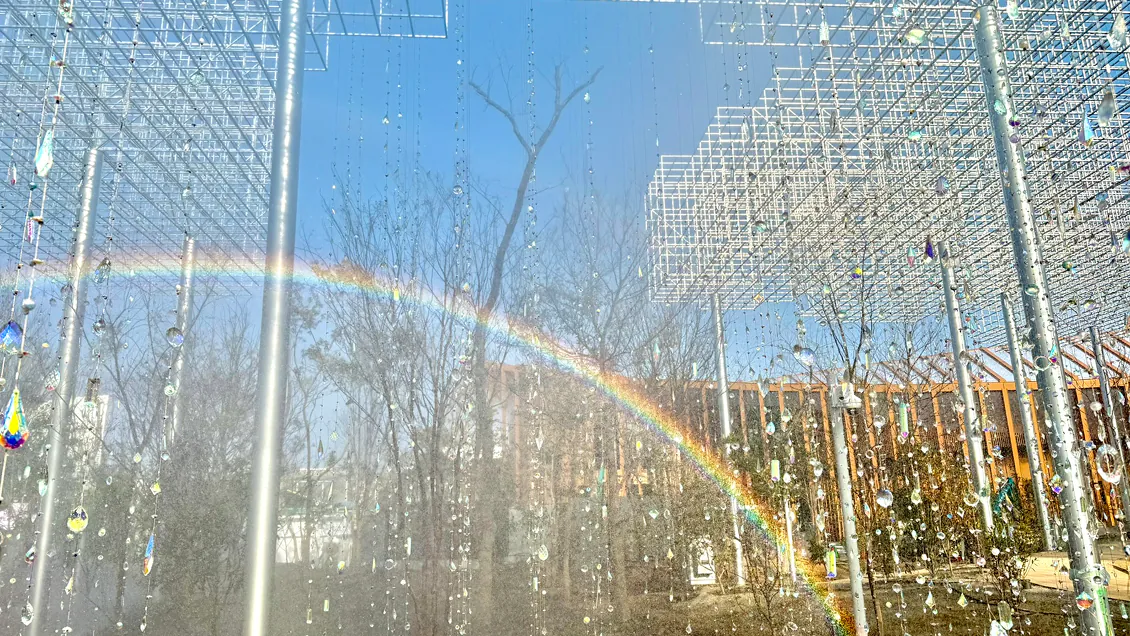
In the pavilion exhibition, we aim to provide a resonant experience where visitors connect with each other and together envision the future. Visitors will form groups, starting from the chance connection of being gathered at the same time and place, and journey through three major resonant experiences together, moving toward the future.
“Better Co-Being” finds parallels with ideas and expressions cherished by many cultures throughout history, and it aims to generate resonance between differing communities.
Consider one interpretation of Leonardo da Vinci’s “Mona Lisa.” According to a relatively recent theory, the painting synthesizes all fields in which da Vinci was engaged: anatomical studies, geology and optics in the background, the sfumato technique softening the subject’s contours, and expressions of emotion and psychological states. Da Vinci may thus have integrated a lifetime of exploration in the “Mona Lisa.”
What might da Vinci have sought to communicate with this portrait of an ordinary woman, not particularly striking by contemporary standards, who exchanges a subtle smile with the viewer? From ancient times to ten thousand years into the future, might such a smile represent a universal form of communication at the core of how humans build communities and cultures? A newborn baby forms its first bond with its mother, or “primary caregiver,” via a smile visible even to its limited eyesight—an affirming emotional connection that underlies individual personality and the fabric of community life.
Look also at the painting’s background, created using the aerial perspective technique da Vinci invented: although the main focus is the subject’s smile, the softly blurred background suggests a gently sloping path leading onward, evoking a future beyond. To feel a sense of tomorrow while sharing a positive connection with another—that might be one interpretation of what da Vinci condensed in this portrait. He left the painting untitled, but if we were to attempt naming it, “Better Co-Being” could capture an essence of that thought experiment, offered here with deep respect for da Vinci’s genius.
Da Vinci brought all his activities together in “Mona Lisa.” In parallel, we too aim to weave a universal inquiry about our shared future into the forest of tranquility and the Better Co-Being Pavilion, collaborating with diverse artists, creators, and staff. Beyond the physical space of the forest, we also seek resonance with various philosophies and artistic expressions passed down through history. By employing digital technologies, ecological restoration, and artistic creativity, we propose a new experience wherein humans, nature, and the future resonate, thereby illuminating the potential of Better Co-Being.
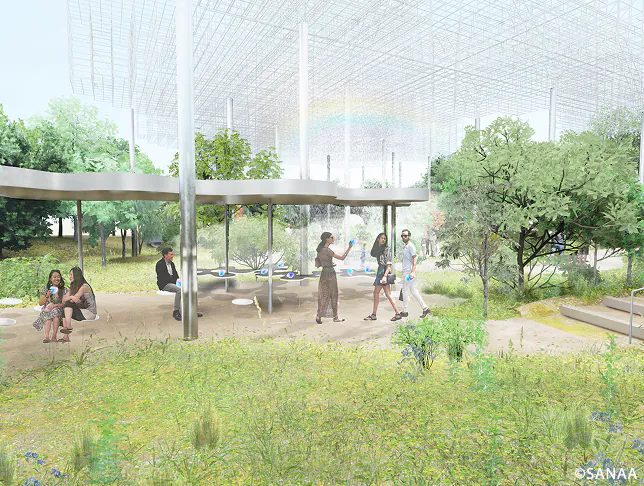
The journey begins at a magical entrance that seamlessly blends into the forest. Here, people who have gathered by chance will form groups and set out on a journey through the pavilion together, envisioning the future.
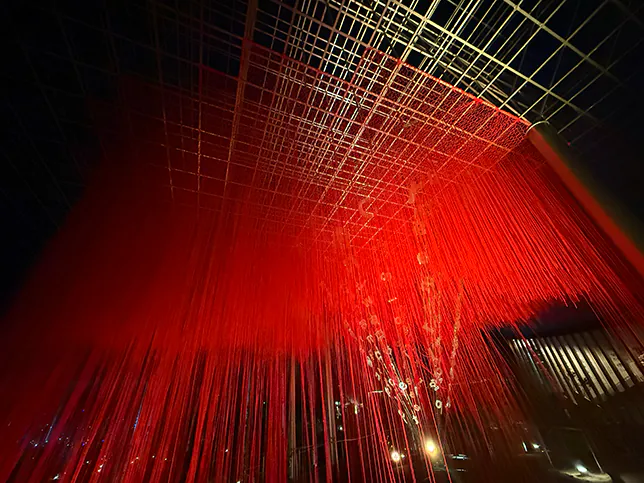
Sequence 1 explores how visitors look inward at themselves and outward toward others, rediscovering what they hold in common. It features diverse motifs linked not only to the Expo’s main theme but also to the focus areas for future Theme Weeks. By engaging with key motifs that illuminate what others hold dear and what we ourselves treasure, visitors gain clues for resonating together as we move forward.
In a small hill-like area within the pavilion, red threads are stretched in multiple layers, intersecting with chair and table shapes formed by wire. Though no one is seated, the suggestion of human presence is palpable in the stillness. Floating letters convey phrases in multiple languages—“Breath of the Earth,” “Voice of the Body,” “Connecting Prayer,” “Invisible Link,” “Doorway to the Unknown,” “Where the Lines Intersect,” “The Endless Journey,” —forming a vast network that gently sways with the threads. This structure hints at invisible connections we typically overlook, creating a shared space for dialogue across different cultures. In the poetic space woven by red threads and text, the potential for interaction is rendered visible despite an apparent absence, prodding us to reflect on coexistence in the future. Integrating various perspectives, the installation prompts visitors to think about how we might live together through open dialogue and creative collaboration. Stepping into this space, one rediscovers elusive connections and may feel guided toward future-oriented action.
Shiota, who often works with thread and everyday objects, explores concepts like “memory,” “presence and absence,” and “connection.” For her, thread can symbolize inner anxieties or isolation, while also suggesting the accumulation of memories or thoughts interlinking toward new understandings. In line with the pavilion’s overarching theme of Better Co-Being—“exploring ways to live together in the future”—Shiota’s “Hill of Language” poetically and spatially poses these questions.
As an example, the network of threads and words visually represents our intangible “resonances.” The sense of “someone is here, yet no one is here” suggests that coexistence and mutual understanding aren’t necessarily about direct physical interaction alone—unspoken feelings also help shape our future. Meanwhile, by tracing threads that extend not just into the “present” but also toward a distant past or an unseen future, the piece invites visitors to contemplate what it truly means to “live together” on a broader timeline.
In this environment, people can discover fragments of words—connected by red threads—that reveal personal aspirations, core values, or future hopes, prompting them to revisit those inner questions. One might uncover connections previously unnoticed, bridging themselves and others. This scenario mirrors the essence of Better Co-Being, which envisions many individuals, each with a unique background, nonetheless walking forward together. In this poetic space Shiota has created, we experience unspoken forms of communication, transcending language and culture, and are reminded that even silent, intangible threads shape our shared future.
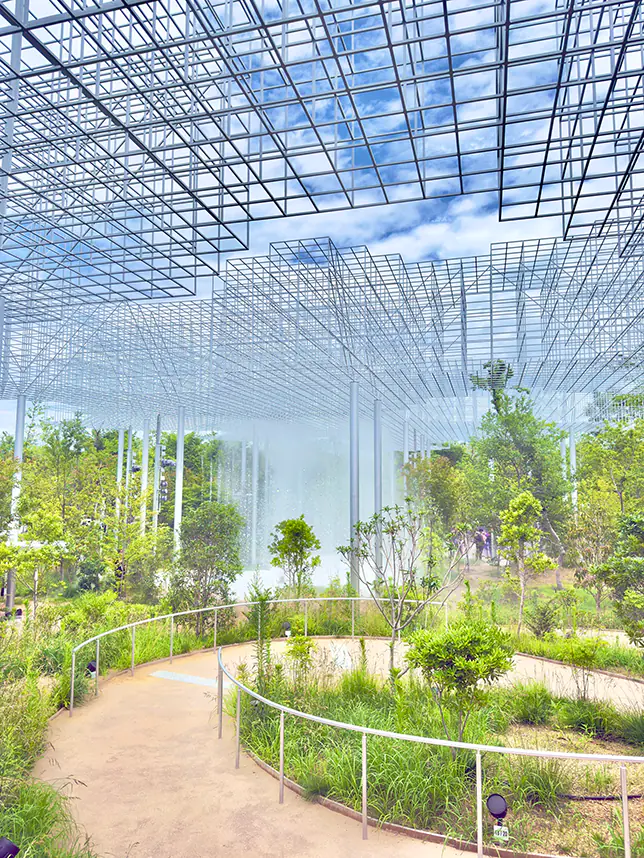
Sequence 2 explores the theme of "Resonance between People and the World," presenting perspectives that resonate with the nature, culture, and lives of people rooted in various regions. By focusing on customs from distant countries, respect for nature, and the way communities are formed, visitors will realize the connection to the foundation of their own lives. Here, through the universal motif of "voice," visitors will listen to the values cherished around the world and feel the continuity between each other. This resonance illuminates the path to a new future.
At the top of the hill, the forest of tranquility merges visually with the pavilion’s canopy in the far distance. Walking down a gentle slope, one encounters Tatsuo Miyajima’s voice-based installation “Counter Voice Network.” Here, people in multiple languages (not just Japanese, but English, French, Malay, etc.) repeatedly count down—“9, 8,7 … 1”—overlapping at different rhythms. Notably, no one ever says “0.” The silent pause between countdowns hints at “death” or “nothingness.” As you approach the source of each voice, the names and languages of the people continuing the countdown are displayed, and related motif stories appear on the web app. The space created solely by voices allows visitors to glimpse others' hearts through words, while also experiencing the diversity and inclusiveness of life.
“Counter Voice Network” highlights the theme of Better Co-Being—how do we live together—through the simple act of counting down. Hearing countdowns in multiple languages intertwining makes us realize that someone else’s “time” is unfolding alongside our own. This invites us to tear down unseen walls that separate us, forging a sense of shared global humanity.
Because the work emphasizes sound, visitors naturally look upward to the open sky framed by the architecture. Immersed in a multi-lingual soundscape of countdowns, they see a forest-sky horizon dissolving into one another, prompting a quiet, reflective mood. After examining one’s inner self in “Hill of Language,” experiencing the overlapping voices in “Counter Voice Network” encourages visitors to listen to the values and desires cherished by others, thus reframing human interconnectedness from yet another angle.
Through this journey, visitors gain an intuitive sense of “Co-Being,” or designing the future while respecting diverse values. Even with differing languages and cultures, we share the same finite existence. Becoming aware of that fact fosters an environment where people naturally care about each other’s visions of tomorrow. In that regard, Miyajima’s artwork immerses us in the countdown, letting us momentarily experience how backgrounds and cultures converge—creating a “Co-Being” that embraces difference. The fleeting silence may evoke not just death or absence but also the emptiness that precedes the emergence of new possibilities—reiterating Miyajima’s core artistic inquiry into the continuity of life and the power of resonance.
Note on Collaboration Artist Recruitment for Counter Voice Network:Counter Voice Network is an immersive sound installation that celebrates the diversity of languages and cultural traditions worldwide. Currently composed of 45 languages, the project continues to seek collaboration artists who wish to participate in their native language. If you are interested in joining this project, please visit the website below for more details.
URL: https://www.countervoicenetwork.com

Sequence 3 addresses how visitors, now having connected with one another, together face the broader world in search of better futures. Accepting differences in viewpoints and values, can we still co-create a preferable tomorrow? Here, the experience of creating a rainbow together, while feeling the connection with the people, plants, nature, and the world gathered here, forms the core. This section symbolizes recognizing our distinct vantage points while simultaneously gazing at the same sky—a gesture paralleling the Expo’s theme, “Designing Future Society for Our Lives.
This piece is an installation that brings to life the idea of “The Greatest Wellbeing with Diversity and Inclusion” a key principle of Better Co-Being. Since the modern era, societies driven by mass production have aimed for the “greatest happiness for the greatest number.” While this has served as a rational guiding principle under finite resources, the digital age has made it possible to generate well-being that respects individual differences. Thus, society is shifting from an era of uniformity to one that embraces diversity.
In the installation, about 400 slender wires rise up to the 7m-high canopy, each wire fitted with a small suncatcher. None of these suncatchers are arranged identically, symbolizing a “non-uniform collection” that celebrates diversity. On sunny days, these catch and refract natural light into rainbow hues; on cloudy or rainy days, a mist and artificial lighting combine in a dreamlike display. Visitors’ movements affect the flow of rain, and the space takes on different moods by day and by night, illustrating how distinct elements can come together in harmony to create new possibilities.
Just as each wire’s alignment is unique, human values and ways of living also vary widely. By highlighting diversity rather than hiding it, the installation reveals that myriad differences can in fact create beautiful resonance, enriching the environment. This reflects how “individual differences,” often overlooked in an age of mass production and consumption, might now be the very key to a new form of shared well-being.
Blending evanescence and vitality, the work hints at new approaches to sustainability and inequality. In the process, it offers a glimpse of “The Greatest Wellbeing with Diversity and Inclusion” By immersing oneself in the ever-shifting tapestry of light, visitors reflect on a collective vision for tomorrow. The exhibit thus challenges society to move beyond division, pointing toward a future enriched by resonance among diverse elements.
When do we feel a sense of the future? Climate change—excessive CO₂ emissions—can leave us feeling overwhelmed by powerful, uncontrollable forces. Yet humanity also has a track record of confronting global challenges through cooperation, as demonstrated by the success in reversing ozone layer depletion via international coordination. As a symbol of that collaborative potential, this pavilion offers an experience of “making a rainbow.” Once viewed as purely accidental, creating a rainbow through collective human intention and effort parallels the process of shaping our future.
Under SANAA’s grid-like canopy—an open structure without walls or ceilings, connecting forest and sky—a plaza becomes the stage for rainbow-making. When a group of people gathers at a point where a rainbow could form, artificial rain begins. Whether a rainbow appears depends on natural elements like weather and time, as well as the viewers’ perspectives and actions. The outcome is never guaranteed; if a rainbow does emerge, the unexpected shared spectacle sparks a memorable experience. Though the rainbow soon fades, even its disappearance becomes a fleeting moment to treasure.
The “resonant sky” here is not just about a visual phenomenon. It unites nature and humans: through the open canopy and falling rain, visitors are deeply reminded of nature’s rhythm and power. It unites people: forming a rainbow requires collective action, with each person’s perspective affecting others, possibly altering the future. It unites past and future: recalling the global cooperation that phased out CFCs brings hope that we can overcome other worldwide problems, including the future possibilities shaped by our behavior now.
Thus, the act of “co-creating a rainbow” embodies the notion that uncertainty can encourage resonance and birth new values, echoing the idea of a “data-resonant society,” which envisions information sharing to enhance our collective future.
Under the canopy, gazing at a sky turned unfamiliar, people can see the future differently through collaboration with others. The moment ephemeral colors appear when rain and refracted light converge—this moment, collectively shaped by many, hints at how fleeting yet powerful resonance can drive better tomorrows.
In “The Sky of Resonance”, under the pavilion without walls or ceilings in the tranquil forest, as people look up at the sky, they will form new relationships with nature, the world, and each other, sensing the potential for creating the future through "resonance." The collaboration of artificial rain and refracted light incorporates chance into intention, creating unexpected spectacles that involve many people. Indeed, the act of gazing up at this resonant sky together becomes a clue to shaping the future.
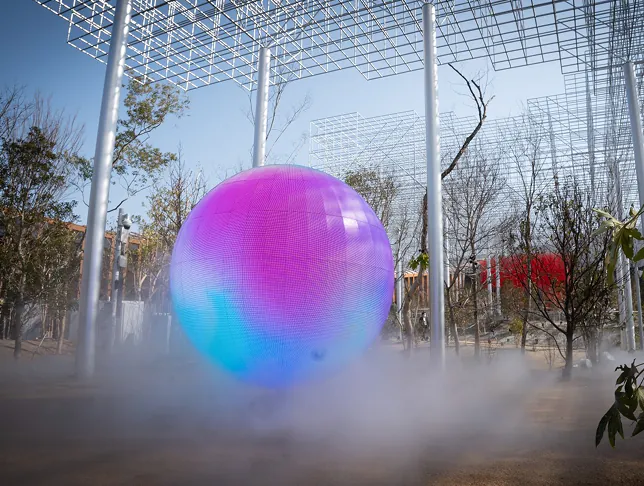
After experiencing the three sequences, the experiences of visitors gathered at that moment will be combined with surrounding environmental data to create a sensory experience focused on video art that imagines the future. Data about weather conditions and visitors’ actions, along with the choices they make for their future, combine to generate a one-time-only, multi-sensory, visual artwork. This interactive encounter weaves together personal memories, motivations, and a broader web of connections, allowing visitors to perceive how they link to the world.
Such resonance is fleeting, lasting only moments in real time, yet it can guide how we walk into the future together. It illuminates how people connect with each other, with nature, and with what lies ahead, embodying the notion of “Better Co-Being.”
This sequence is shaped by Hiroaki Miyata and Rhizomatiks. A spherical LED installation stands at the center, and about fifteen visitors at a time contribute their personal experiences and inspirations to form an evolving vision of the future. Real-time environmental data and spatial attributes influence the images, which go beyond mere display into a conversation about tomorrow. Rather than being just another technological exhibit, this is a place for each visitor to re-examine their ties to themselves, others, and the world at large. It underscores that the future arises through our interwoven connections; the diverse resonances we create are crucial for shaping the next era.
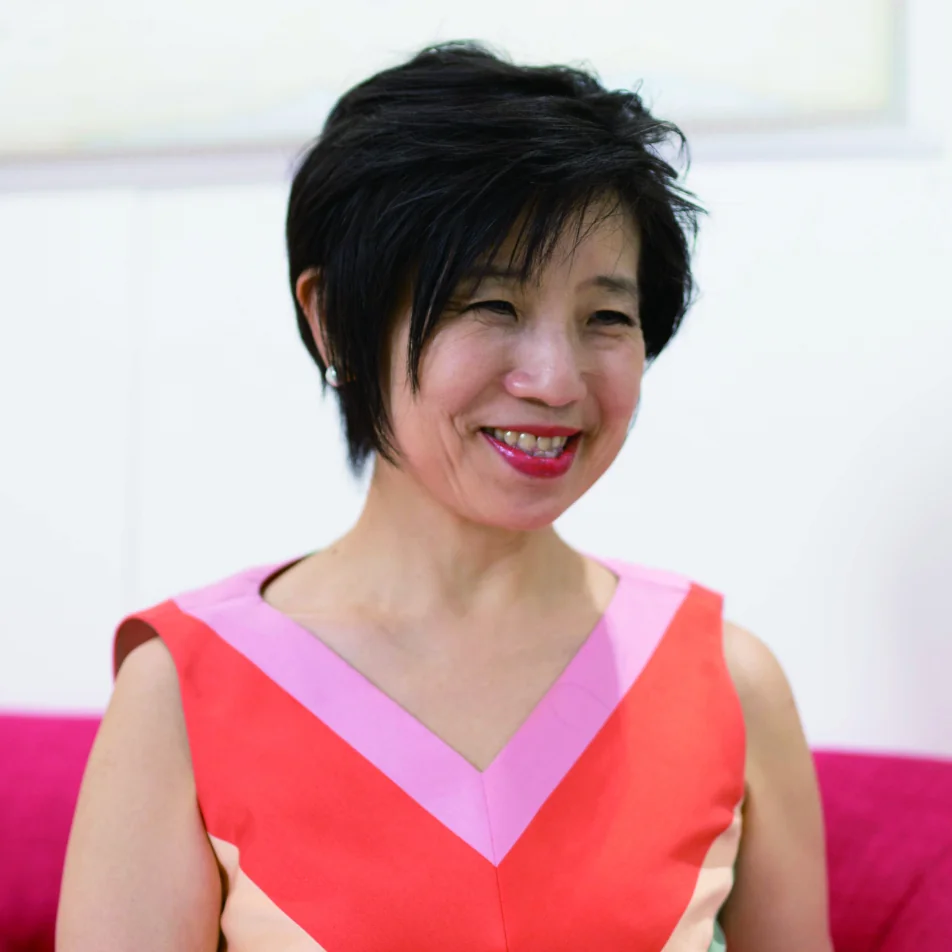
Curator. Visiting Professor at Graduate School of Management, Kyoto University, in "Curatorial Theory and Practice"; Program Director of Art & Design at the International House of Japan; Visiting Professor at the Research Institute for Humanity and Nature; and Professor Emeritus at Tokyo University of the Arts. Former Director of the 21st Century Museum of Contemporary Art, Kanazawa.
She has been honored with the Commissioner for Cultural Affairs Award (2020), the Chevalier of the Ordre des Arts et des Lettres (France, 2015), the Order of Cultural Merit (Brazil, 2017), and the Officier of the Ordre des Arts et des Lettres (France, 2024).
Hasegawa has curated numerous biennales in Istanbul (2001), Shanghai (2002), São Paulo (2010), Sharjah (2013), Moscow (2017), and Thailand (2021), and international exhibitions including Japanorama: A New Vision on Art Since 1970 at the Centre Pompidou-Metz (2017), and Fukami: A Plunge into Japanese Aesthetics in Paris (2018). Her publications include Art and New Ecology: Anthropocene as Dithering Time (Ibun-sha, 2022); Japanorama: Un Archipel en Perpétuel Changement (Centre Pompidou-Metz Éditions, 2017); and Performativity in the Work of Female Japanese Artists in the 1950s–1960s and the 1990s (Modern Women: Women Artists at The Museum of Modern Art, MoMA, 2010).
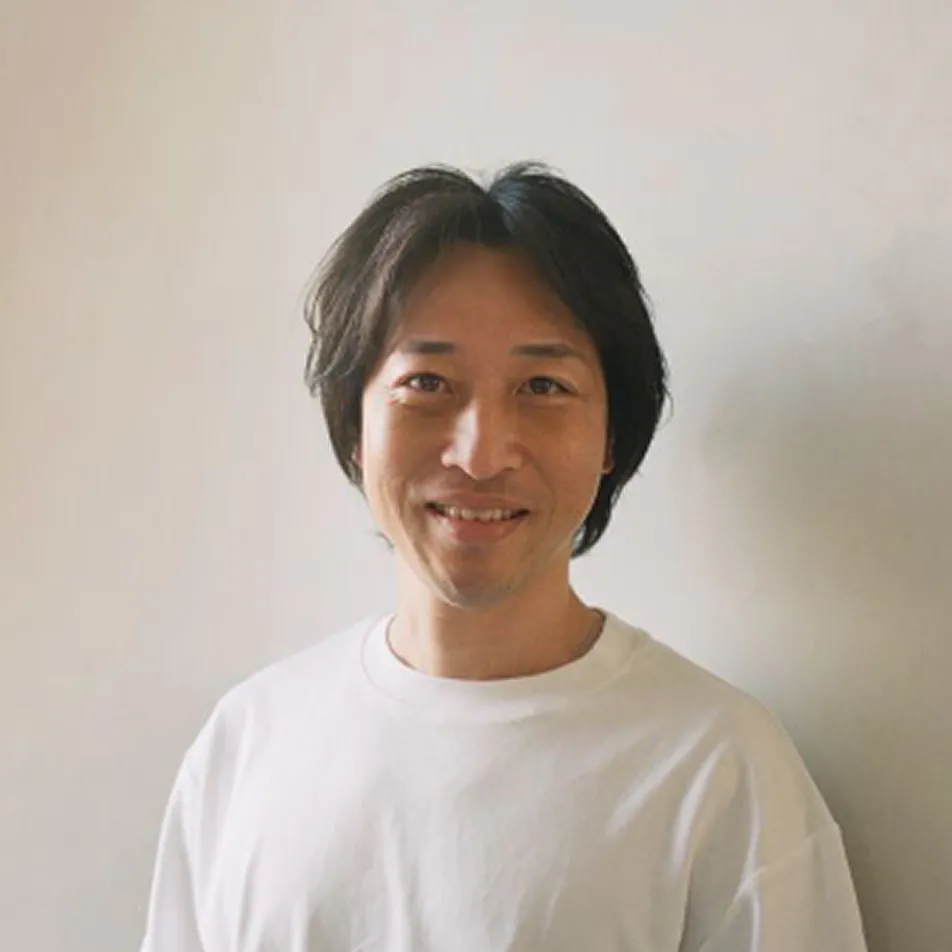
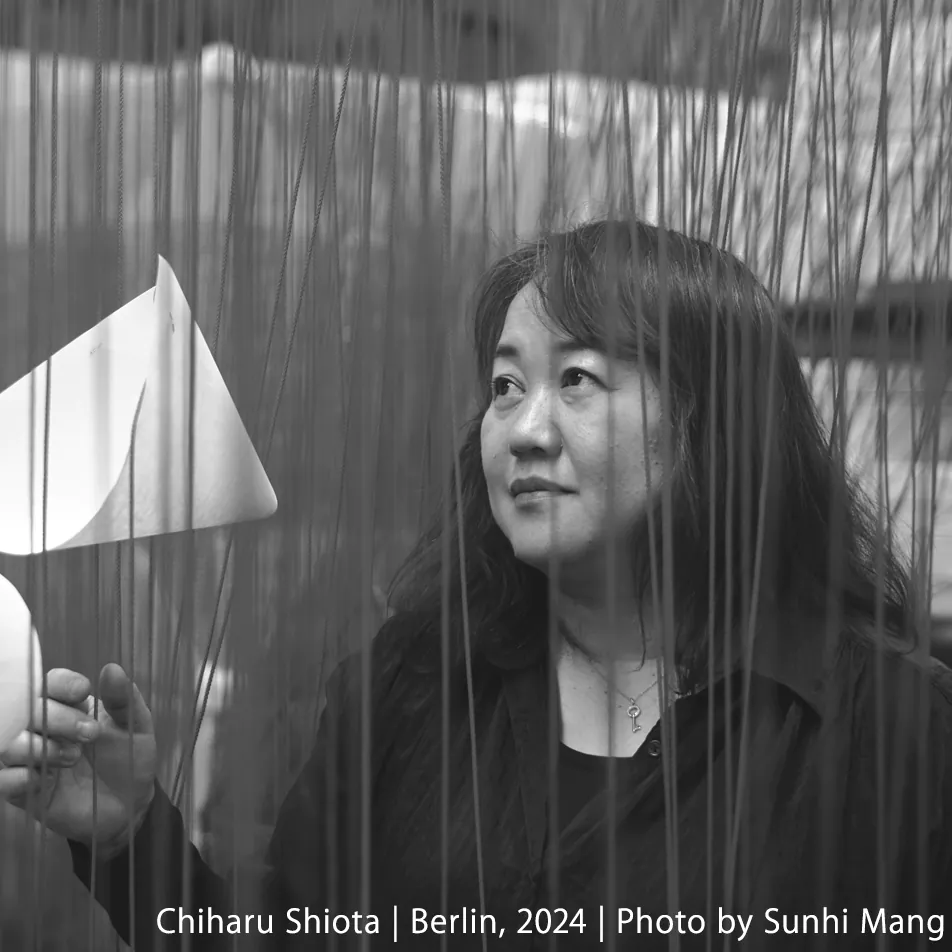
SHIOTA Chiharu was born in 1972 in Osaka, Japan and now lives and works in Berlin. She has produced works using a variety of techniques, including sculpture, photography and video, with a focus on large-scale installations that weave threads of absent existence, such as memories that reside in places and objects, while confronting the fundamental human issues of life and death, and exploring what it means to live and what existence is. In 2008, she received the Minister of Education, Culture, Sports, Science and Technology’s Art Encouragement Prize for New Artists. In 2015, she was selected to represent the Japanese Pavilion at the 56th International Art Exhibition of the Venice Biennale. In 2019, she held her largest-ever solo exhibition, “The Soul Waves” at the Mori Art Museum. In 2020, she received the 61st Mainichi Art Award.

MIYAJIMA attracted international attention in 1988 when he was invited to participate in the New Talent section of the Venice Biennale with his work using digital numerals. Since then, he has had numerous exhibitions in Japan and abroad and has exhibited his work in more than 250 locations in 30 countries. He stayed in New York at the invitation of the ACC in 1990,and in Paris at the invitation of the Fondation Cartier pour l’art contemporain in 1993. His major works include Mega Death (1999/2016). He is involved in the “Revival of Time” Kaki no Ki project (1995-), an art project in which children around the world raise the seedlings from an A-bombed persimmon tree, and in the “Sea of Time – Tohoku project” which aims to commemorate the victims of the Great East Japan Earthquake, preserve the memory of the disaster, and create a future for Tohoku.
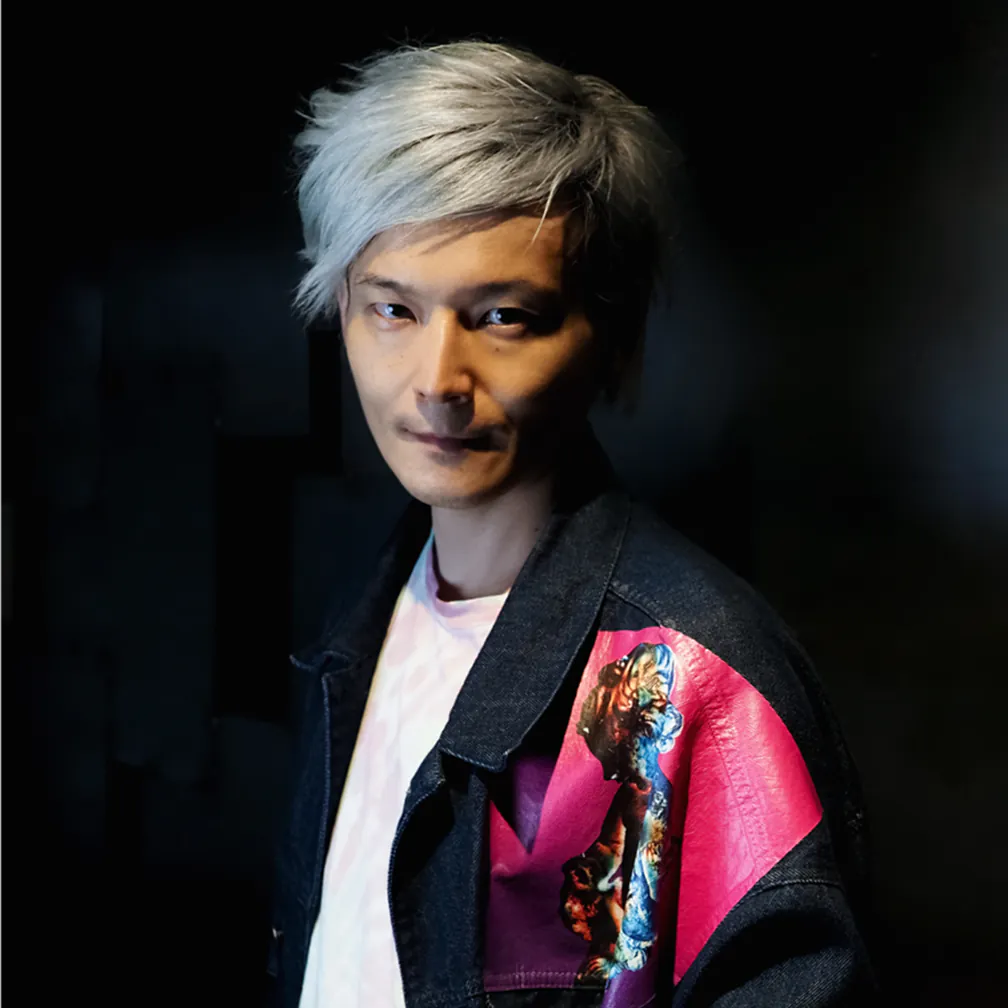
Scientist / Professor at Keio University School of Medicine
Born in Gifu Prefecture in 1978. Professor at Keio University School of Medicine. As a scientist, he works across various fields such as healthcare, policy, and social design, using data science as a foundation to envision the future of people and society. Through practices that connect the intellect and sensibility of science, he collaborates with diverse fields. As an artist, he is active as part of the creative team Eternity in a Moment (EiM). His notable works include "Embracing Lights," "Eternity in a Moment," "Where Humanity Meets Nature," and "Dreams of the Beyond in the Abyss." In 2025, he served as an artist and co-curator for "Lights of the beyond, Shadows of this world" (Kyoto City KYOCERA Museum of Art) in collaboration with NINAGAWA Mika, attracting over 250,000 visitors. As the president of the Co-innovation University (tentative name), scheduled to open in 2026, he oversees the overall concept and supervises campus design with architect Sou Fujimoto, creating a new experimental space where learning and creativity intersect. At the core of his activities lies the vision of Better Co-Being, a philosophy that consistently breathes life into the idea of diverse entities resonating together to create the future.
EiM is a creative team formed by Hiroaki Miyata, the theme producer of this Expo, photographer and film director Mika Ninagawa, creative director Isao Kuwana, lighting director Koshiro Ueno, and music producer Gakuto Kenmochi, and others. The team works by assembling a diverse lineup of members for each project.
Major exhibitions that the team has been involved with include Mika Ninagawa: The Butterfly Journey Embracing Lights (Appi Art Project, 2022), Mika Ninagawa: After glow/Eternity in a Moment (Tomio Koyama Gallery Maebashi, 2023), Mika Ninagawa: Eternity in a Moment (TOKYO NODE, 2023-2024), NINAGAWA Mika with EiM: Where Humanity Meets Nature (Hirosaki Museum of Contemporary Art, 2024), and Dreams of the Beyond in the Abyss (Forest Festival of the Arts Okayama, Makido Cave, 2024), NINAGAWA Mika with EiM:Lights of the beyond, Shadows of this world(Kyoto City KYOCERA Museum of Art, 2025).
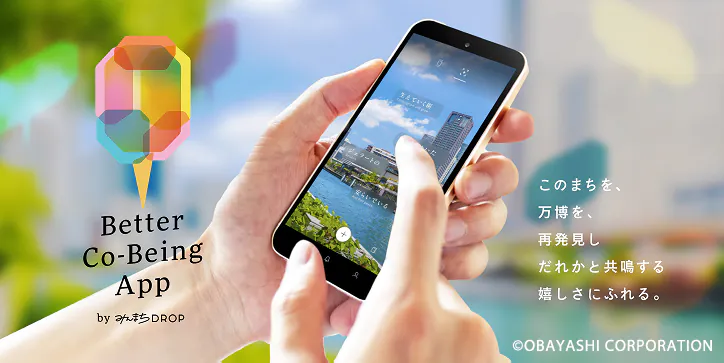
This web app supports visitors' resonance experiences. In addition to providing explanations of the art installations, it analyzes and expresses the experiences and choices of visitors gathered at that moment based on the seven themes of the Expo, encouraging awareness of one's own values and the diverse values of others. In the finale of the pavilion experience, Sequence 3, the app combines these experiences and choices with weather data collected by on-site environmental sensors (provided by Obayashi Corporation) to create a unique multi-sensory experience centered on video art, presenting different future images each time. The app can be used throughout the Forest of Tranquillity and the entire Expo site. By utilizing AR technology, visitors can use their smartphone cameras to encounter the thoughts and emotions of others at various locations, fostering connections and resonance.
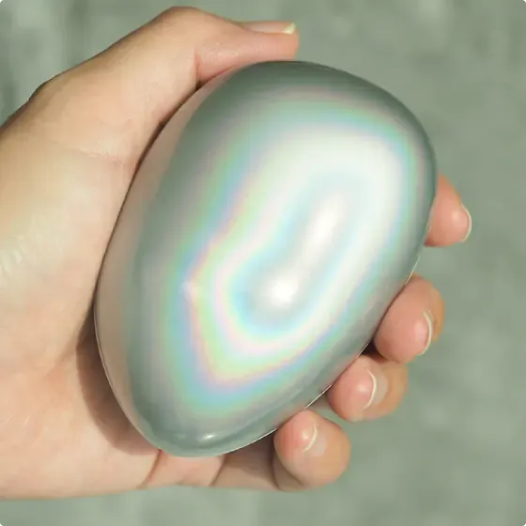
Applying 3D haptic technology, which created an illusion in the brain through special vibrations, the Wonder Stone “echorb” will lead visitors to a resonant experience through a mysterious sense of touch. In addition, by working with heartbeat sensors (millimetre-wave sensors and load sensors provided by Murata Manufacturing), each visitor’s heartbeat can be placed in their own stone, and visitors can tour the pavilion while feeling their own life in the palm of their hand.

Through three resonant experiences, the pavilion values the diverse futures envisioned together by the visitors who came to gather to connect and resonate with each other at that time on that day.. At the end of each experience, visitors will receive one of seven coloured bags, inspired by Better Co-Being’s Diver Sphere motif, as a gift corresponding to the various futures that they have envisioned through the experiences they had.
The bags will contain “Wellness Energy” in exclusive packaging designed for the pavilion. This gift is based on the concept of “vital life energy”, which emerged from Otsuka Pharmaceutical’s rethinking of water, nutrition, and oxygen, which are essential for human life. We believe that when each individual shines, we resonate more strongly with each other, leading to Better Co-Being.
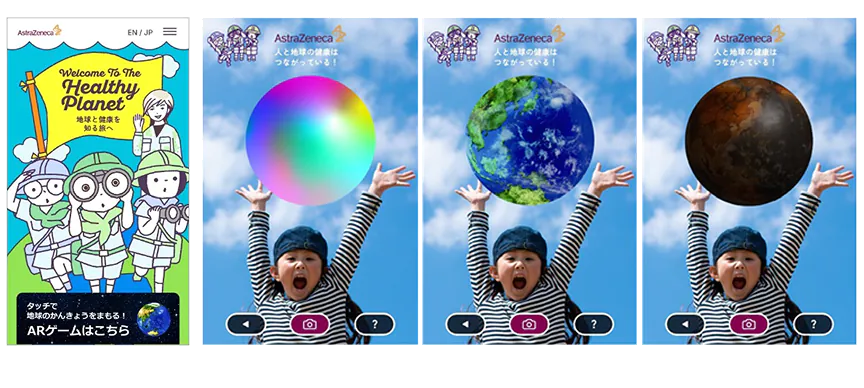
Through collaboration with fashion designer Yuima Nakazato and Goldwin Inc., the uniforms express the pavilion's three resonances: "between People," "between People and the World," and "between People and the Future."
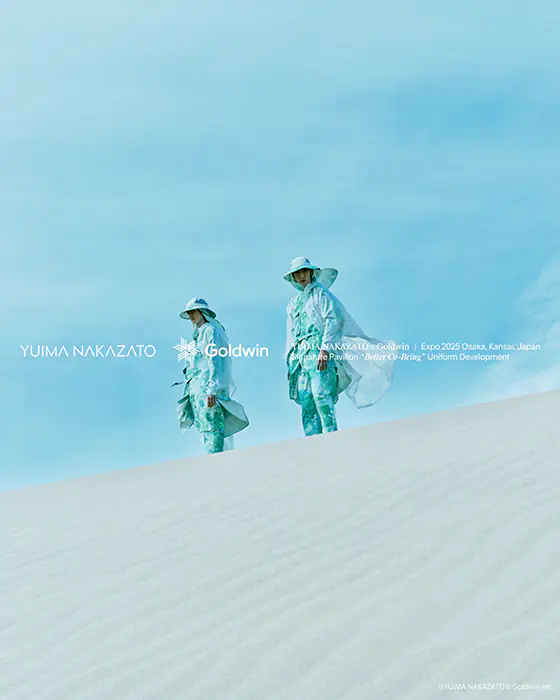
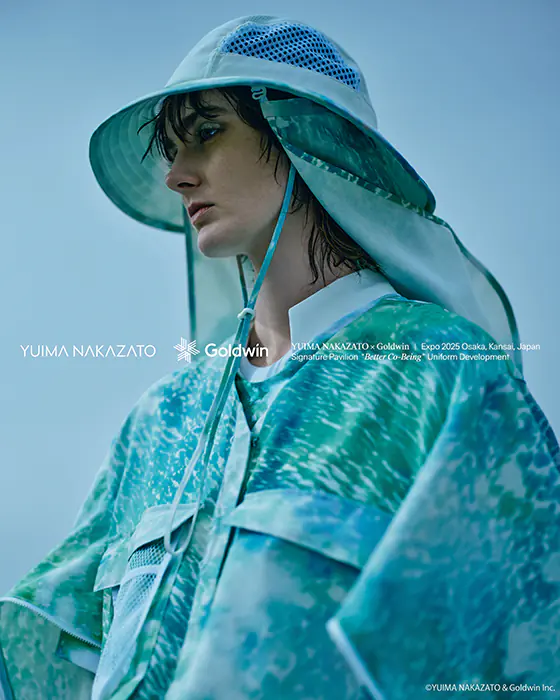
“Inspired by how sunlight shows many faces according to time of the day and place, I wanted to create clothes that could be worn and shaped in infinitely many ways according to the wearer and the environment. I would like to include the word impermanence in the title of this uniform to reflect how every object keeps changing.” -Design concept in the words of Yuima Nakazato
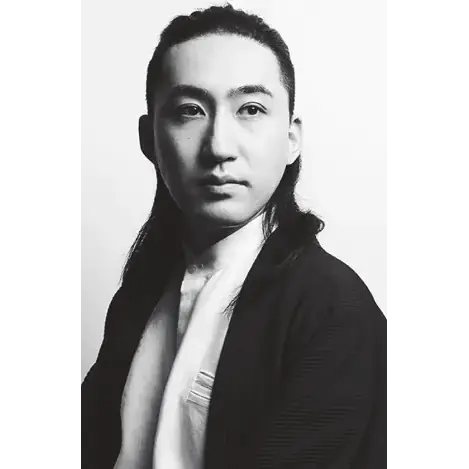
Nakazato was born in 1985 and graduated from the Fashion Department of the Royal Academy of Fine Arts, Antwerp, in 2008.
In July 2016, he was chosen as one of the Paris Haute Couture Fashion Week’s official guest designers, and to this day he is the only Japanese designer to present his collections at Paris Haute Couture Fashion Week. More recently, his retrospective exhibition “BEYOND COUTURE” was held at the Calais Lace and Fashion Museum, a public museum in France. He designs costumes for stage performances, including for operas and ballets by the Boston Ballet in the U.S. and the Grand Théâtre de Genève in Switzerland. He is also the founder of the fashion award “FASHION FRONTIER PROGRAM” for the next generation of creators.